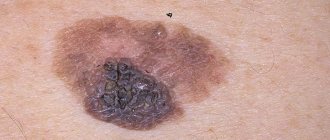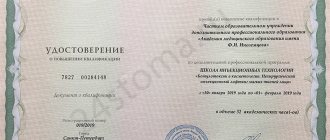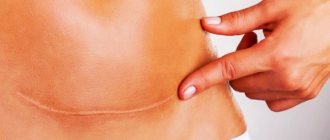Dissatisfaction with the chin is radically different from some ghostly complexes. It shapes the contours of the face, creates harmony in profile and front, or, on the contrary, disrupts it. We asked the experts what could be done.
The chin reflects a person’s character and largely determines the overall perception of the image.
The shape depends on the structure of the bones of the lower jaw and muscles: the chin, depressor of the lower lip, depressor of the angle of the mouth, as well as fat deposits. A heavy chin gives a woman’s face a rough appearance, while a too small chin gives an expression of despondency. “The chin plays an important role in the perception of appearance,” says Elena Chirikova. — A person’s face is perceived as beautiful if it has harmoniously developed and balanced features, one of which is a slightly protruding chin. A seemingly small flaw - a small or sloping chin - can spoil the overall picture, and turn a beautiful, pretty face into an unattractive one.”
Usually the shape of the chin is an inheritance from relatives, passed down from generation to generation, but there are exceptions. For example, micrognathia - underdevelopment of one of the jaws - may be a sign of a genetic disease. It is often combined with glossoptosis (underdevelopment and retraction of the tongue), cleft of the hard palate and other developmental anomalies.
In each case, aesthetic medicine offers optimal solutions that will bring obvious results and change a person’s life for the better.
What is the difference
The main surgical methods that plastic surgery offers to change the chin are mentoplasty (genioplasty) and mandibuloplasty. “Mentoplasty is a surgical intervention directly on the chin area with the aim of reducing or enlarging it,” explains Elena Chirikova. — To reduce the chin, the bone structure of the chin is corrected; for enlargement, individual implants are installed.”
“Mentoplasty allows you to harmonize the face and strengthen the frame of its lower parts,” says Elena Karpova, “which prevents further ptosis of the soft tissues of the face (sagging).”
“Mandibuloplasty is the surgical correction of congenital and acquired defects of the lower jaw,” continues Elena Chirikova.
— This operation pursues not only aesthetic goals (elimination of asymmetry, improvement of the contour of the chin, etc.), but also solves problems of a functional nature (correction of pathological bite, normalization of articulation, chewing, etc.). Depending on the nature of the defect, mandibuloplasty may include osteotomy with lengthening of the jaw segment (for asymmetry), resection of the jaw with bringing together the mental protuberances (for a massive chin) or expanding the distance between the mental tuberosities (for hypotrophy of the chin), etc. Often, mandibuloplasty is supplemented with chin replacement "
Chin reduction techniques:
Chin reduction surgery (genioplasty) is most often resorted to by women due to dissatisfaction with the shape of the lower jaw or the presence of a skin-fat fold.
Reducing osteotomy of the mandible:
Osteotomy is also performed to reduce the chin. The “extra” bone fragment is cut off, polished if necessary, brought to the desired shape and repositioned with a posterior displacement using titanium plates. After surgery, the stitches are placed under the jaw.
Double chin liposuction:
To correct a double chin, liposuction is performed on the lower side of the jaw using a vacuum or radiofrequency method. Only a few punctures remain, which then quickly heal, and if there was no significant amount of subcutaneous fat, the skin quickly restores its elasticity, begins to fit tightly to the jaw and the face takes on neat features.
How to do more
There are several ways to enlarge a small chin. “The simplest is the introduction of a dense filler,” says Elena Chirikova, “a very convenient way for the patient to understand how much the chin needs to be enlarged and how much its changes change the appearance. The only drawback of this method is its short duration and the need for correction. Another way is to enlarge the chin with a silicone implant.
From my point of view, the most worthy and quite simple to install. The implant can be selected by shape, size, volume - the most suitable for a particular patient - and, if necessary, changes can be made to it with ordinary scissors or a scalpel, cutting off all unnecessary, working like a sculptor.”
To achieve the desired chin shape once and for all, the best option is to contact a plastic surgeon and use the second method. This method of mentoplasty is more complex, but gives a lasting result. Today there are no problems with choosing a polymer implant. The range is so wide that you can choose an option that exactly matches all the anatomical features of a face of any shape. Only a specialist can decide on the choice of implant.
“To understand how your appearance will change, there are several options for “trying on” a new image,” says Elena Karpova. — It is possible to visualize a picture of a simulated changed appearance by enlarging the chin on a computer.
You can make a 3D model of your face using modern technology and experiment with the size of your chin. And another effective way to understand whether you like your look is to inject a filler based on hyaluronic acid. If you don’t like it, the filler will degrade and everything will return to its place.”
Chin fat not going away?
Sometimes getting rid of a double chin on your own can be an impossible task. Did the method described above not help you?
The list of probable causes is short:
- You expected to get the result very quickly, literally “tomorrow”.
- You don't have enough time to do double chin exercises and exercise every day.
- The chin was inherited from my parents.
- You are over 40 years old. At this age, loose skin on the chin practically does not tighten on its own and spoils the oval of the face even after massive weight loss.
- You have Central Asian, Caucasian or Slavic roots. The facial structure of these nations physiologically predisposes them to the appearance of a double chin even at a very early age.
But don't be upset. There are several extremely effective ways to remove a double chin quickly and without plastic surgery. Removing the double chin with lipolytic drugs will help.
What are implants made of?
In addition to silicone implants, there are also bioprostheses (based on the patient’s cartilage tissue). Despite the fact that they are as safe as silicone, and therefore are also often used to enlarge the chin, experts note some nuances that can sometimes arise when using them.
“Of course, silicone implants are ideal for chin augmentation, because they do not affect the resorption of bone tissue,” notes Elena Chirikova.
— Silicone elastomer is a semi-soft material, and when changing such an implant, we see the absence of any resorption in the area of the bony part of the chin. If the implant is made of a hard material (for example, a rib), then the bone part of the chin experiences severe pressure from the bioimplant, which forces it to follow the contour of its posterior (facing the bone) part, and the bone part of the chin is resorbed, that is, it loses its own volume.”
Recovery period:
Mentoplasty is a low-traumatic operation, but requires care in the postoperative period. During augmentation surgery, it is important to allow a pocket to form that will tightly hold the implant. Therefore, the pressure bandage must be worn for about three weeks. At this time you need to sleep on your back, limit facial movements, and do not go to the sauna. Within three days, the patient may experience pain, especially when chewing, notice hematomas and swelling, which will then go away on their own. If stitches are applied, they are usually removed within 7-10 days. If access was made through the oral mucosa, you need to follow a diet - do not eat hot, very cold, spicy, and in any case avoid solid foods.
How to do less
For those with a large chin, the choice of correction method is limited to two options. In cases of severe fat deposits and excess skin, simultaneous liposuction and lifting of the lower third of the face are performed in combination with tightening of the skin and subcutaneous muscle of the neck. Today, there are endoscopic techniques that leave virtually no traces. If the cause of massiveness is not excess muscle or fatty tissue, but bone (lower jaw), then an osteotomy operation with removal and/or relocation of bone tissue fragments is necessary.
“There are two surgical methods for reducing the chin: the bone tissue is either simply excised, or the bone fragment is shifted posteriorly,” says Elena Chirikova. — The result of the operation is corrected, if necessary, by introducing fillers or your own adipose tissue.
There are also cosmetic methods for reducing the chin - the introduction of lipolytics and other drugs, but they cannot serve as an adequate replacement for surgical intervention. Their capabilities are seriously limited, and the results last no more than a year. Only surgical chin surgery can solve the problem once and for all.”
Alternatives to mentoplasty
There are some alternatives to chin correction surgery that are less invasive and faster, but often not as effective:
- Fillers . For minimal changes, fillers such as Radiesse can be injected into the chin area to change its shape. However, they do not provide a long-term solution to the problem. Men often choose this method of chin surgery.
- Submental liposuction is a procedure that involves removing fatty tissue to make a major change to the chin. This procedure has a faster recovery period than chin correction surgery, but it is also invasive and may not produce significant results.
- Orthodontic surgery - This procedure makes changes to the patient's dental structure, which is expected to change the chin. However, this method is long and achieving a pronounced effect may take several years.
How is the operation performed?
To correct a double chin with excess fat deposits, 30–40 minutes are enough; surgery to enlarge the chin using implants or lipofilling will require 1.5–2 hours; chin reduction surgery is the most complex type of operation and can last up to 2–2 hours. 5 o'clock. All surgical interventions are performed in a clinical setting under general anesthesia. To install the implant, the surgeon needs to make an incision. “There are two options for the location of the scar line: in the submental area or in the oral cavity,” says Elena Karpova. In the area between the gum and lip. Any of the prostheses is installed under the periosteum of the lower jaw, which reduces the likelihood of its displacement.
“Rehabilitation takes on average one to two weeks,” continues Elena Karpova. “In our practice, we often combine mentoplasty with facelifting, which allows us to obtain a more pronounced and lasting effect.”
Rhinoplasty is often performed simultaneously with plastic surgery, which allows you to get a completely harmonious appearance in one operation.
“In general, mentoplasty—chin reduction and enlargement—is a fairly simple, short-term operation with a short rehabilitation period,” says Elena Chirikova. “Mandibuloplasty is a more complex operation that requires a long recovery process.” During the first week after surgery, discomfort, swelling, and numbness of the tissue are noted. The final result can be assessed after one and a half to three months. However, many are afraid of more serious side effects that may occur after chin surgery, such as problems with speech and chewing.
“Mentoplasty, like any operation, is associated with certain risks,” states Elena Karpova. — After it, rejection or displacement of the implant, bleeding, and loss of sensitivity are possible, but we have not observed such complications as problems with speech and chewing in our practice. All of the listed cases of complications are extremely rare in the practice of an experienced surgeon.”
All about chin surgery
The concept of “ideal profile” applies to people who have harmonious facial features. Harmony is created by the lines of the forehead, nose and chin. Do you want to get closer to the ideal of your appearance? Nothing is impossible! Plan changes and make them reality! You can start with chin plastic surgery, or mentoplasty.
Follow the example of many Hollywood stars and Russian show business. After all, it’s enough to remember that the brightest blonde of the 20th century, Marilyn Monroe, was “born” precisely thanks to mentoplasty. With this operation, the unknown Norma Jean Baker began to conquer the Hollywood Olympus.
Similar operations were also performed by Angelina Jolie and Gwyneth Paltrow, Beyoncé and Demi Moore.
In Russia, the most famous person who has undergone chin surgery is, of course, Ksenia Sobchak. In the past, a “blonde in chocolate”, and in the present, a politician and public figure, she, according to rumors, specifically took a vacation to spend time in a German clinic. As they say on the sidelines of the stars, mentoplasty cost Ksenia a tidy sum - about $10,000.
Mentoplasty – what is it?
Mentoplasty is a plastic surgery to correct the chin to change the position of the chin bone.
The ideal shape of the chin is considered to be 2-3 mm in front of the deep part of the back of the nose. The height of the mandible should not exceed 50% of the height of the lower third of the face. The correct width of the chin is the distance between the eyebrows or the wings of the nose.
For a more pronounced result, chin surgery is often combined with rhinoplasty and cheekbone correction.
The effect obtained from chin plastic surgery can be assessed after 4-6 months, when the swelling subsides and the bone structures and implants take their final shape.
The result of mentoplasty lasts throughout life. Correction may be required if endoprosthetics was performed using the patient’s own tissue, as well as if a mechanical injury occurred.
Kinds
Mentoplasty is performed to reduce, increase or correct the fatty tissue of the mandibular bone to correct the facial profile.
Chin augmentation This is a fairly common procedure, since the anomaly of underdevelopment of the lower jaw is more common. Shape correction is carried out in two ways:
- Osteotomy. A portion of the lower bone is resected and then brought forward by shifting the periosteum of the jaw and raising the bridges of the bone. In this position it is fixed with titanium plates. The resulting voids are filled with the patient's fat emulsion. As a rule, access to the operating area is through the mouth.
- Endoprosthetics. It is carried out through an external incision. The patient's cartilage tissue or special silicone material is used as an implant. Biological cartilage is not rejected, does not provoke an allergic reaction, but resolves after 3-4 years. Because of this, it is rarely used. The introduction of silicone monolithic or perforated products is more often practiced. They contribute to further filling of the voids with local adipose tissue. In addition, prostheses are lightweight, due to which they cannot be touched, felt, or noticed.
Manufacturers offer a variety of shapes and sizes. Mostly women install rounded implants with small side elements. Men prefer to install large products with elongated wings.
Chin reduction refers to the displacement of a protrusion of bone tissue or its dissection. This is done in two ways:
- Bone grinding. The mandibular angle is filed down to achieve symmetry, and then the shortened structure is held together with sutures.
- Jaw resection. The required part is removed and the bone is modeled to the desired size. Then sutures are placed with collagen threads. They move the resulting fragment back.
The choice of technique depends on the anatomical structure of the patient’s face.
Preparing for surgery
During the examination, the surgeon compares the three parts of the face, thereby determining the imbalance of the lower third in relation to the middle and upper part of the face. Then the doctor determines the type of operation and method of performing it, selects the type and shape of implants. Many specialists offer a 3D modeling service, in which the planned effect is visualized on a computer monitor.
It is imperative to consult with an anesthesiologist, dentist, or therapist. If there are bite pathologies or abnormalities in the development of the facial bones, then an examination by an oral and maxillofacial surgeon is also needed. Based on the results of a cephalometric study, a conclusion is given on checking the occlusion of the teeth. If the closure is incorrect, then surgical correction of the bite is performed.
To identify any contraindications, you need to take a full package of tests and undergo an examination:
- Urine and blood analysis.
- Analysis for hidden infections.
- Coagulogram.
- X-ray of the skull bones.
- Electrocardiogram.
- Fluorography.
After diagnosis, you should begin preparing the body:
- For three weeks, reduce your exposure to the sun and do not visit the solarium.
- For two weeks, stop taking hormonal, painkillers, homeopathic medications, contraceptives, vitamin E, blood thinners (Aspirin, Heparin, Cardiomagnyl, etc.). If discontinuation of the medication is not possible, the anesthesiologist must be notified.
- For a week, remove spicy, smoked, salty foods from your diet.
- For seven days, limit smoking and give up alcoholic beverages.
- For two days, treat the oral cavity three to five times a day with antiseptics for disinfection (applies if surgery is planned through internal access).
- For two days, carry out antibacterial washes of the face and neck several times a day (if surgery is planned through an external incision).
- Eat your last meal 8-9 hours before the event, choosing light food. Surgery is performed on an empty stomach.
On the day of the event, you cannot use care products, decorative cosmetics, or perfume.
Indications and contraindications
The main reason why patients turn to a plastic surgeon is dissatisfaction with the aesthetic appearance:
- Absence of an acute angle in the lower third of the face (a protruding chin distorts the proportions).
- Asymmetry due to bevel to one side.
- Protruding part of the middle part of the lower jaw (more than 5 mm).
- The presence of a double chin resulting from age-related ptosis.
- Dissatisfaction with the shape (square, high, narrow oval, split type).
- Deep hole.
However, there may be more indications for mentoplasty. For example, the medical reasons for performing an operation are as follows:
- Defects of the jaw bone, congenital or acquired.
- Asymmetry of facial features due to an excessively long chin.
- Asymmetry of facial features due to insufficient chin size. A shape that is too small enlarges the upper and middle third of the face.
- Correction of maxillofacial trauma. Fractures, improper fusion of bone tissue.
- Anomalies of the facial bone.
The following absolute contraindications may be the reason for refusing surgery:
- Age up to 21 years. Until this point, the lower jaw bone is still developing.
- Circulatory pathologies, including decreased coagulability.
- Decompensated diabetes mellitus.
- Epilepsy.
- Chronic diseases of the heart, blood vessels, kidneys and liver.
- Disturbances in the normal functioning of the thyroid gland.
In this case, it is worth considering alternative correction options - lipofilling and fat injections or liposuction.
It is necessary to postpone the procedure for some period of time if there are relative prohibitions:
- Infectious or viral processes.
- The presence of scratches, wounds and other skin damage in the correction area.
- Presence of seizures.
- Allergic reaction to anesthesia components.
- Dental diseases. Inflammation of periodontal tissues, for example.
Stages of chin plastic surgery
An external or internal incision is used to access bone structures. The external dissection takes place along the lower fold at the bottom of the tubercle, and the internal one - through access from the oral cavity. The choice of method remains with the surgeon.
Markings are applied to the face, along which the tissue is subsequently cut. The patient is given anesthesia.
Progress of chin reduction surgery:
- The periosteum is separated through an incision under the chin in a natural crease. At this stage it is important not to damage the facial nerve.
- The tip of the bone is sawed horizontally with an oscillating saw.
- Part of the bone is removed.
- The fragment is moving backwards.
- Fixed with a cerclage suture in a static position.
- Stitches are applied.
With reduction mentoplasty, the tissue is quite injured, so the operation is performed under general anesthesia. If there is a double chin, then excess fatty tissue, part of the cartilage and muscle tissue are removed.
Duration of surgical procedures: from half an hour to three hours.
Scheme of plastic surgery for chin augmentation using endoprostheses:
- From the side of the oral cavity, an incision is made on the mucous membrane between the lower lip and gum.
- The periosteum is separated along the edge of the lower jaw by excision of several layers of tissue.
- A bed for the implant is created, which is additionally disinfected
- The prosthesis is inserted and secured to the bone structure.
- Sutures are placed with threads that dissolve on their own.
The procedure takes from half an hour to one and a half hours.
Photos "before" and "after"
By comparing different photos, you can be sure that chin correction lengthens the neck and improves the proportions of facial features. Many surgeons practice a combination of mentoplasty with removal of Bisha's lumps. The face becomes narrower.
Before surgery, it is recommended to study the work of a photographic specialist. It is necessary to pay attention to the results obtained by patients.
After plastic surgery, the doctor shows the “before” photographs taken and asks to compare the result in frontal and lateral projections. The difference is dramatic: the profile is leveled, the face looks harmonious and symmetrical. The male profile becomes sharper.
Rehabilitation
The patient is under the supervision of medical personnel throughout the day. Bed rest and rest should be observed. Within 10 days, the lower half of the face becomes numb, and there is a feeling of tightness of the skin and muscles. This process is due to the presence of postoperative edema.
After surgery, a fixation bandage is attached to support the tissues in the desired position. It must be worn for at least two weeks.
The first five days there is pain, discomfort when talking and eating, and hardening of soft tissues. Painkillers and cold application may improve the condition. A course of antibiotic therapy reduces the likelihood of infection.
The procedure for removing sutures is carried out after seven days, after which you are allowed to begin work duties.
After another week, the severity of hematomas and bruises decreases. After the wounds have healed, after about a month, the stitches are practically invisible and do not leave rough scars.
Among the restrictions in the recovery period, the following should be highlighted:
- Eating hard foods that require prolonged chewing. It is necessary to eat only liquid and soft foods - purees, juices, cereals, cottage cheese. To reduce the movement of the maxillofacial bones, you should eat food through a straw. Chewing function returns to normal after 30 days.
- Sports activities. Physical activity and heavy lifting increase the speed of blood flow, which provokes the appearance of hematomas. Men need to avoid traumatic sports, such as boxing and any expected mechanical impact.
- Tilts down.
- Smoking. Nicotine reduces tissue healing because it thins the blood flow.
The prohibitions must be observed for about a month in order to minimize the load on the chin, reduce pain, prevent displacement of the implant and not cause complications.
The patient must comply with the following rehabilitation rules:
- Walk with your head raised.
- Keep your head upright while sleeping. You can sleep on two or three pillows in a semi-sitting position.
- Rinse your mouth several times a day with an antiseptic solution (with internal access).
- Treat surgical sutures with a solution of Chlorhexidine or Miramistin.
- Maintain facial calm. Do not smile, laugh, tense your lips, open your mouth too much, etc.
The recovery period takes about a month, but it increases if an osteotomy was performed.
Upon completion of rehabilitation, the preliminary result can be assessed. If there is a dent, it may be caused by incorrect selection of the implant, failure to follow the installation technique, or uneven redistribution of the fat emulsion. In addition, due to the individual characteristics of the body, a dimple may appear. This fact is not a complication.
Contraindications for surgery
- Heart and pulmonary failure;
- Infections and inflammatory processes;
- Diabetes;
- Oncological diseases;
- Bleeding disorders;
- Exacerbation of chronic diseases
Elena KARPOVA, (@elena76016) Doctor of Medical Sciences, Associate Professor of the Department of Skin Diseases and Cosmetology, Russian National Research Medical University named after. N. I. Pirogova, plastic surgeon at the Danishchuk Clinic, member of the OPREH, member of the American Academy of Facial, Plastic and Reconstructive Surgery
Elena CHIRIKOVA, (@doctor_chirikova) plastic surgeon, Ph.D., member of OPREH, ISAPS
Michelangelo (Michelangelo)
New Italian cocktail. Unsurpassedly effective. Well tolerated. His reputation is as impeccable as the creations of the Maestro who gave him his name . It deservedly holds and is not going to give up the title of drug No. 1 in European Union clinics to anyone.
.
Injections for double chin Michelangelo is used for significant volumes between the chin and neck.
It will take about 4-6 procedures with an interval of 8-10 days. Sign up »
Review from Sergei, 35 years old:
“I went to the clinic regarding figure correction: stomach, back, sides, the so-called “lifebuoy.” I want to share with you my results after introducing the Italian cocktail Michelangelo
(
Michelangelo
). This is unreal!! In just two procedures, the waist size visually decreased (before the procedure 89 cm, after 87 cm), weight (up to 76.1 kg, after 74.6 kg). Easy and unobtrusive, without grueling trips to the gym - a very good result in a short time!”
Chin slimming with INNO-TDS
The Spanish drug INNO-TDS Draining ppc was created specifically to target fat traps, one of which is the fat under the chin.
It specifically destroys the membranes of fat cells and transforms solid fat into an emulsion that is easily processed by the body. Therefore, INNO-TDS eliminates even those local fat deposits that cannot be eliminated through fitness and diet.
It will take from 4 to 6 procedures with an interval of 14 days each. Sign up »
Aqualix: a new alternative to liposuction
Expert comment:
“The drug Aqualix was created by a Spanish professor of plastic surgery specifically for the correction of fatty areas on the face and body that are not amenable to weight loss.
It is injected through cannulas into the fat layer and destroys fat cells.
Using Aqualyx intralipotherapy, the surgeon achieves the same effect as after liposuction without an operating room, pain and anesthesia in literally 2-4 procedures.”
Maxim Vasiliev, plastic surgeon.
Review:
“To be honest, I didn’t even try to lose weight. My weight suits me quite well. But the “pillow” between the chin and neck is not.
I chose double chin injections as a method of solving the problem for one reason - it’s simple. No need to put in any effort
.
On Friday I asked to leave early and had injections in my chin. Of course, a little pleasant. But Anya has a light hand.
Saturday morning I woke up, stretched as usual, yawned - and my chin literally sunk into my neck. Such a pleasant and long-forgotten feeling!!! It was worth a little patience for this!”
Olga, 34 years old.
Sometimes simply removing a double chin with injections is not enough. The sagging skin fold left after getting rid of fat requires attention.
Strengthening your chin will help: myostimulation, microcurrent therapy, massage and the elastin Japanese cocktail “Sakura”, which is prepared individually each time for the needs of your skin.











